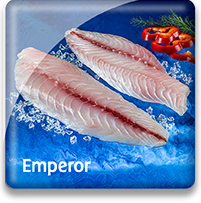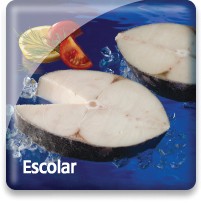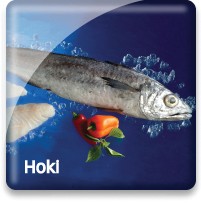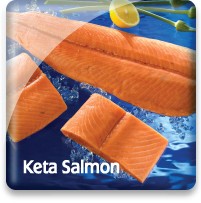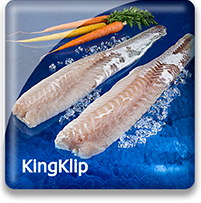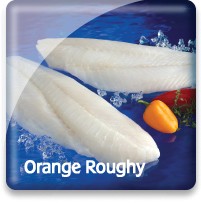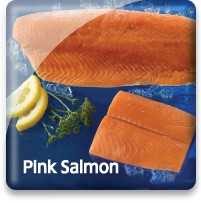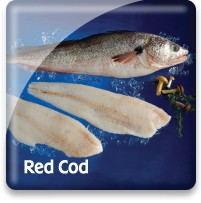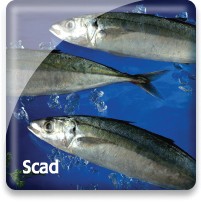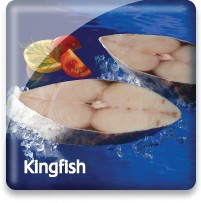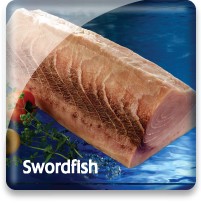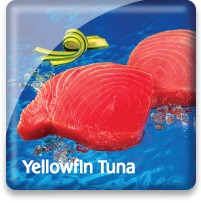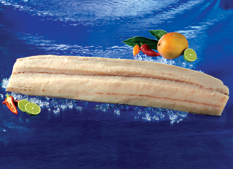
Wahoo

Market Name: Eating QualitiesDelicate texture and mild flavor, wahoo is a versatile cooking fish. It has a less of the “blood meat” or the strong oiler taste seen in other migratory fish. Wahoo is a lean protein option and its fat content is lower than tuna or mackerel. Poaching or marinades help to softens the texture and is a good compliment to wahoo’s mild flavor; also helps to keep the fish moist, this fish can become dry.
Wahoo is also known as ono, or ocean barracuda.
|
Description & CharacteristicsThe Wahoo is a dark blue scombrid fish found worldwide in tropical and subtropical seas. Some say that the name "Wahoo" is a derivation of the name of the Hawaiian Island Oahu, which was sometimes spelled Wahoo, while others say the name derives from the exclamation of some fishermen, "Wahoo!" who have hooked into the extremely fast running fish. The fish is also known as Ono, after the Hawaiian word for "delicious". A large relative of the mackerels and tunas, wahoo can reach over 100 pounds, 40-65 inches in length, and it is reported they can live up to 5 or 6 years. They are a steel blue fish with small scales, a large mouth and can swim over 45 miles per hour. Wahoo are an important game fish caught off southern Florida, Gulf of Mexico, the Caribbean, and the South Pacific and is greatly appreciated in Hawaii, where it is called ono. Hawaii is where the majority of the U.S. wahoo is caught. It is a good eating fish, similar to the large mackerels and especially Spanish mackerels. Usually sold at around 30lbs, is it found in tropical seas but is not abundant and thus has limited fresh supplies. Frozen wahoo is imported from China, Ecuador, and other Pacific Islands including American Samoa in steak and fillet form. Their diet is similar to migratory tunas; they eat jacks, pompanos, butterfish, and squid. Wahoo stay in tropical and subtropical waters and some tagged fish were reported to travel over 1,700 miles from their original tagged location. Wahoo are an expensive fish to commercially catch because they are a solitary and are only sometimes found in small schools. Wahoo is managed in the Atlantic by the South Atlantic Fishery Management Council and in the Pacific by the Western Pacific Fishery Management Council. Both have management plans, in the Atlantic it is called the Fishery Management Plan (FMP) for the Dolphin and Wahoo Fishery of the South Atlantic Region. The FMP is currently trying to regulate current harvest levels and is working to stop any future fisheries. In the Pacific it is in both the Pelagic Fisheries of the Western Pacific Region FMP and the Highly Migratory Species FMP. The Pelagic FMP is working on the future framework for management in the Exclusive Economic Zone for the U.S. Pacific Islands and in the Highly Migratory FMP; wahoo are being monitored as another fishery’s bycatch. In the Gulf of Mexico, wahoo are not regulated.
Wahoo is usually cut for steaks and fillets. It has a solid white flesh which when cut into slices has a circular rings seen in the flesh. Other Resources |
Handling Instructions for Wahoo
Our frozen wahoo (also called ono) fillets, portions and loins should be stored at or below 0°F (-18°C) and then thawed properly when ready to cook. The frozen shelf life for our wahoo is 18 months. Links to proper seafood handling instructions: NOAA - Fish Watch: Handling Seafood and A Consumer Guide to Safe Seafood Handling.
Thawing Wahoo
Thawing is accomplished by removing the fillets, portions, and loins from their original packaging and placing them in a sealed plastic container or bag and placing in the refrigerator (33 to 39°F) for 12-24 hours or until thawed. This is our recommended thawing method for wahoo fillets, portions, and loins. Wahoo that is not consumed promptly after thawing needs to be refrigerated between 33 and 39°F and totally consumed in 2-3 days.
Important Instructions for Wahoo
Consuming wahoo immediately after proper thawing yields the best quality. Wahoo is naturally high in the essential amino acid histidine and must be kept under proper refrigeration (33-39°F) once thawed to prevent the formation of histamine that can cause an allergic type reaction called scombroid poisoning. Histamine may be formed from histidine at unsafe holding temperatures over 40°F if certain marine bacteria are present. To prevent this, always store thawed wahoo at between 33-39°F.
The Federal Food, Drug and Cosmetic Act now requires that all foods that are not raw agricultural commodities and that contain a major food allergen be labeled to clearly identify the name of the food source form which the allergen is derived. (21 CFR U.S.C. 343(w)(1)). The act defines eight foods, and any ingredients derived from these foods as major food allergens: Fish, Crustacean Shellfish, Milk, Eggs, Tree Nuts, Peanuts, Wheat & Soybeans. The name of the food source that must be listed on the label for fish or crustacean shellfish must be the specific type of fish or crustacean shellfish. The market names of species of fish and crustacean shellfish should be used to identify the food source of these two major food allergens. If you intend to re-pack these seafood products, be sure the allergen is declared in either one of two ways:
1) Within the list of ingredients
or
2) In a separate “Contains” statement immediately after or adjacent to the list of ingredients.
Consult the Fish and Fishery Products Hazards and Controls Guidance, Fourth Edition, Chapter 19 for more detailed information on the labeling of food allergens.
Cooking Tips
Wahoo can be prepared using a wide variety of cooking techniques. Link to wahoo cooking tips and recipes.
Taiwan
The island of Tawian, shaped like a tobacco leaf, nation, is located off the coast of China where it is officially part of the Republic of China. Some 23 million people live in an area that is just 245 miles long and 89.5 miles wide, making Taiwan the second-most densely populated country in the world.
While it offers few opportunities for recreational fishing, Taiwan’s commercial fishing industry is well-established, with a fleet of vessels that fish around the world for tuna, sharks, herring, reef fish, horse mackerel, sardines, squid and octopus. Aquaculture is also an important new industry in Tawian, with freshwater farms growing shrimp farms, and tilapia, and marine farms growing shellfish such as clams and oysters.
Go Blue! Seafood Sustainability Spectrum*Click here for an explanation of our Sustainability Spectrum 
Sustainability AssessmentWahoo is a pelagic, highly migratory species common in tropical and subtropical oceans worldwide. Wahoo mature relatively quickly, making them moderately vulnerable to fishing pressure. Sea Port’s supply of wahoo is landed as bycatch by Taiwan’s distant water tuna and swordfish longline vessels. Longline fisheries generally have minimal negative impacts on the sea floor because they do not come in contact with the bottom; however, there are substantial problems with bycatch of protected, endangered, and threatened species (PET) in this fleet. There are no known stock assessments for Wahoo, and it is not currently managed at the national or international level.
Environmental Impact: Moderate to HighThe gear used to catch Wahoo, longlines, generally have minimal negative impacts on the sea floor because they do not come in contact with the bottom; however, there are no known stock assessments, management plans, or quotas in place. Bycatch of PET species are problematic in the Taiwanese longline fleet.
.jpg)
Sustainability Improvements NeededStock assessments are needed to determine the health of Wahoo populations and to guide the setting of responsible quotas. Improved monitoring and data reporting on catch and bycatch from Taiwan’s high seas tuna fleet is needed.
Actions that Sea Port is UndertakingSea Port believes that the high fecundity and growth rate of Wahoo is currently guarding it from becoming overfished. However, Sea Port is requiring that their suppliers provide fishing vessel identification (when available), catch methodology, and catch area information. In doing so, Sea Port hopes to encourage the Wahoo fishery to collect additional critical catch and resource data where none currently exist. This increased availability of data will allow for fishery management schemes to be establish or improved upon to assure the sustainability of the Wahoo fishery. Sea Port believes that, in aggregate, choosing from a diverse variety of seafood is better for sustaining the world’s seafood resources and that Wahoo should be a part of this variety. We created the sustainability assessments for each of our seafood items in order to reveal the existing and potential environmental impacts and risks that are associated with producing them for human consumption. This allowed us to establish the starting position for each of our seafood items along our progressive Go Blue! Seafood Sustainability Spectrum®. These assessments are only a single snapshot in time and because of this, we will continue to assess and update the critical sustainability needs associated with our supply sources and issue updates to the Go Blue! Seafood Sustainability Spectrum® as needed. There is a growing global awareness for the need to assure the sustainability of farmed and wild caught seafood and because of this; all around the world positive changes are rapidly occurring at all levels of the seafood supply chain. We will continue to spread this growing awareness and work with our many industry partners to improve the sustainability of all seafood, which we believe is the ideal protein of choice to feed an ever growing world population. Our Go Blue! Seafood Sustainability Spectrum® serves as our compass and yardstick as we strive to move all our products forward to becoming more sustainable. Please join us in this committed quest and Catch Our Wave® to sustainability by choosing a diverse variety of responsibly produced seafood as part of your diet.
|



